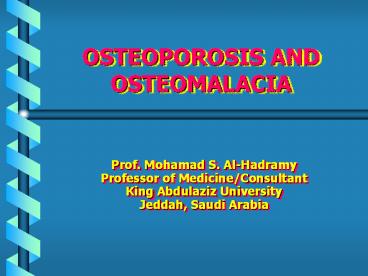OSTEOPOROSIS AND OSTEOMALACIA - PowerPoint PPT Presentation
Title:
OSTEOPOROSIS AND OSTEOMALACIA
Description:
OSTEOPOROSIS AND OSTEOMALACIA Prof. Mohamad S. Al-Hadramy Professor of Medicine/Consultant King Abdulaziz University Jeddah, Saudi Arabia F. 19-year-old presented ... – PowerPoint PPT presentation
Number of Views:2774
Avg rating:3.0/5.0
Title: OSTEOPOROSIS AND OSTEOMALACIA
1
OSTEOPOROSIS AND OSTEOMALACIA
- Prof. Mohamad S. Al-Hadramy
- Professor of Medicine/Consultant
- King Abdulaziz University
- Jeddah, Saudi Arabia
2
- F. 19-year-old presented with difficulty in
walking for many years, especially going
upstairs. She felt parasthesia in hands feet
and occasional spasm. P/E waddling gait. - Ca 1.8 mmol/l (2.1-2.6) P 0.54 mmol/l
(0.7-1.4). Alk Phos 562 ( - 125). - What other test results you need?
3
- Alb Urea PTH
4
- What signs for low Ca would you look for?
- Chovestick
- Trouseau 4 min.
5
OSTEOMALACIA
- Raised bone turnover
- Failure of mineralization
- Most common cause decreased Vitamin D
- Darker skin more susceptible
6
- Less common
- Heriditary resistance to Vitamin D
- 1 a-hydroxylase def.
- Familial X-linked hypophosphatemia
- Mesynchymal tumours produce phosphatonin
7
Radiology
- Subperiosteal resorption of phalanges
- Looser zones
- Brown cysts
8
Chemistry
- Decreased corrected Ca
- (40-Alb) x 0.02 Ca
- Decreased P Why?
- Decreased urinary Ca
- Decreased 25 (oH) Vit. D
9
Treatment
- 1000 2000 IU Vitamin D/day 500 1000 mg of
Ca/day. Rarely 50,000 100,000 u/d or 1 a 0.5
2.5 µg/day . shorter acting to decrease tox. - Check Ca Q 2-4 weeks
- Phosphate for hypophosph Rickets
10
OSTEOPOROSIS
- Low bone density
- Microarchitectural deterioration
- ? fractures
11
- Balance between bone formation and bone resorption
12
- Max bone mass at 25 35 years
- Increased by exercise and good Ca intake. Later
bone mass ?, especially with ?oestrogens
(Menopause).
13
Dx T score. What is it?
- Normal T 1
- Osteopenia -1gt T -2.5
- Osteoporosis T lt - 2.5
- Severe osteoporosis T lt-2.5 with 1 or more
fragility, fractures
14
Chemistry normalWhy ?alk, but not persistent
15
Primary Osteoporosis
- Senile or post-menopausal 95
- Indiopathic
16
Secondary Osteoporosis
- Endocrine
- Cushing exog steroids
- Hyperthyroidism
- Hypogonadism
- Hyperparathyroidism
- DM
- Proclatinoma
- Acromegaly
- Preg lactation
17
Connective Tissue
- Osteogenesis inperfecta
- Marfan
- Homocystinuria
18
Drugs
- Heparin
- Steroids
- Anti-convulsants
19
Renal
- C R F
20
Nutrition and GIT
- Malabsorption, Celiac
- Gastrectomy
- T P N
- Hepatobiliary disease
- Chronic hypophosphatemia
21
Elite female athletes and anorexia nervosa
22
Risk increased by
- F sex
- Menopause
- Decreased Ca
- Smoking
- Alcohol
- Inactivity
- Leanness
- White Race (? black)
23
Signs Symptoms
- Asymptomatic unless
- Back pain
- ? Height
- Kyphosis
- Effect especially in
- Dorsalverts
- Femoral neck
- Distal radius
24
DD Lytic lesions
- Ca breast, Lung, Kidney, Thyroid
- Prostate ? wall sclerosis
- MM ? generalized thinning
25
Prevention
- Exercise
- Good Ca intake
- Non-smoking
26
Screening
- Screen post-menopausal
- F gt64 or with multiple risk factors (e.g.,
?weight, fragility fractures - Frag of limb or spine post fall from standing
height or less
27
TREATMENT
- Ca 1200 mg/day
- Vitamin D- 400-2000 IU / day
- HRT
- Biphosphonates
- Calcintonin
- S E R M S
- Parathyroid hormone
28
Thank You !































